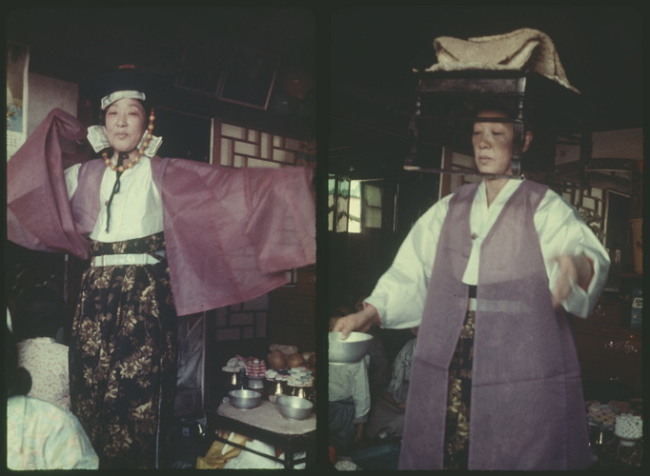Despite the long history of shamanism in Korea, remaining shamanistic relics and records are considerably few partly due to oppression following the dominance of Confucianism and modernization.
Folklorist Kim Tae-gon (1936-1996) was the first scholar who paid attention to the disappearing shamanistic practices in the 1960s when it was considered a “primitive, backward and outdated culture.”
The National Folk Museum of Korea sheds light on the lifetime work of folklorist Kim, who collected more than 30,000 items during his 36 years of studying shamanism. His entire archive of a total of 31,742 items was donated by his wife in 2012 following his death in 1996. Part of them are now on exhibit at the museum.
Folklorist Kim Tae-gon (1936-1996) was the first scholar who paid attention to the disappearing shamanistic practices in the 1960s when it was considered a “primitive, backward and outdated culture.”
The National Folk Museum of Korea sheds light on the lifetime work of folklorist Kim, who collected more than 30,000 items during his 36 years of studying shamanism. His entire archive of a total of 31,742 items was donated by his wife in 2012 following his death in 1996. Part of them are now on exhibit at the museum.

The exhibition reveals a rare video recording of what is believed to be the last shamanic ritual held in Seoul ― a ritual dedicated to the General Namyi of Joseon that took place in Yongsan until the early 1970s. Kim’s recording in 1972 was known as the last ritual as it was never held after that.
“This is the ritual that consoles the spirits of the late General Namyi who was falsely accused of plotting treason during Joseon Dynasty. It was held in the town regularly,” explained Jang Jang-sik, curator of the exhibition.
Amid the effort to recover local shamanistic rituals, Kim’s records helped re-stage the traditional shamanic ritual in Seoul in 1980s. It was also registered as an intangible heritage by the Seoul Metropolitan Government.
Kim became known in the academic circles in 1966 after the publication on the study of a song performed during the shamanic ritual that sends the soul of a dead man. It was considered as the first academic study on shamanism.
He traveled across the country to meet shamans and study distinctive local shamanistic cultures. He could not visit North Korea, but his research covered shamanistic practices in North Korean provinces with the help of shamans who defected from the North.
The exhibition showcases shamanistic paintings and tools Kim collected from his field trips. Shamanic tools include mirrors, sticks and performing clothes, which are considered to be rare as shamans were known to have discarded tools they used right before they died.
“Kim maintained a close and friendly relationship with shamans. He asked them to give him the tools if they were going to destroy them,” explained Jang.
In the collection of paintings of shamanistic spirits, the museum found valuable pieces of paintings that depicted scenes from the Chinese tale of “Romance of Three Kingdoms.” The painting belonged to a shamanic temple in Dongmyo in Seoul, which worshipped Guan Yu, one of the generals who served as a founder of the state of Shu Han in the Three Kingdoms period of China. Guan Yu has been largely worshipped as a shamanic figure in East Asia.
Different shamanic temples worshipped different shamanic figures. More shamanic paintings are on view, including the portrait of a general worshipped by a shaman nicknamed “twin’s mother” in Cheongryangri in Seoul.
“View on Korean Shamanism by Folklorist Kim, Taegon” continues until June 22 at the National Folk Museum of Korea, located near Gyeonggokgung Palace in Seoul. The museum offers descriptions of the exhibits in English, Japanese and Chinese. Admission is free.
By Lee Woo-young (wylee@heraldcorp.com)









![[Kim Seong-kon] Democracy and the future of South Korea](http://res.heraldm.com/phpwas/restmb_idxmake.php?idx=644&simg=/content/image/2024/04/16/20240416050802_0.jpg&u=)







![[KH Explains] Hyundai's full hybrid edge to pay off amid slow transition to pure EVs](http://res.heraldm.com/phpwas/restmb_idxmake.php?idx=652&simg=/content/image/2024/04/18/20240418050645_0.jpg&u=20240418181020)

![[Today’s K-pop] Zico drops snippet of collaboration with Jennie](http://res.heraldm.com/phpwas/restmb_idxmake.php?idx=642&simg=/content/image/2024/04/18/20240418050702_0.jpg&u=)